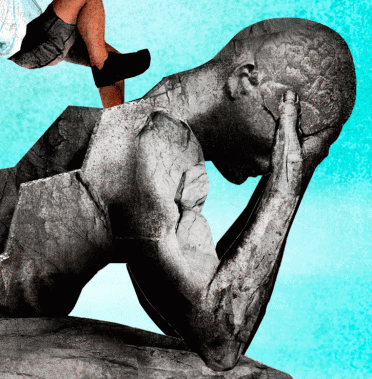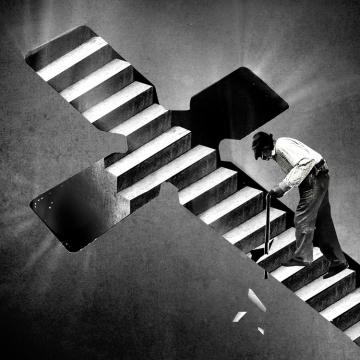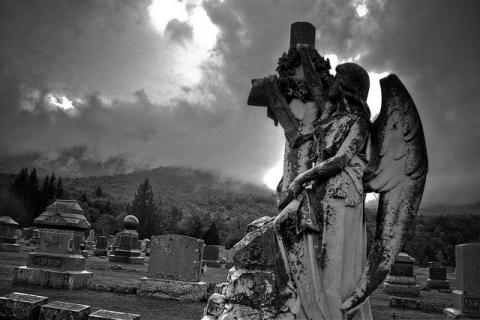Ted Kooser's poem "The Corpse of an Old Woman" can be found in Vol. 251, No. 6 (Nov., 1966), p.14, http://www.jstor.org/stable/25116500.
THE CORPSE OF AN OLD WOMAN
It has been lying on a braided rug
with a teacup in its hand since yesterday
at supper-time, and the neighbor-ladies shrug
and say "She lets the lights burn night and day."
Its cat sits in the window, watching birds,
and the phone rings now and then, mistakenly;
the mailman bangs the box-lid to be heard;
Someone may stop this afternoon for tea.
- Ted Kooser
Some years ago, on a typically freezing Iowa February morning, I went out to start my car, in order that it could warm up a tad in the 20 below weather. Doing so at 6:00 a.m. in the morning was nothing unusual for me at that time as I started my cubical-based life by 6:30 am every morning. Returning to the car a few minutes later, not having paid heed to the icy conditions overnight, I slipped in my dress shoes and fell straight back. The only thing that saved me from a concussion was the back pack I had slung over my right shoulder which provided enough of a cushion between me and the unforgiving cement that I was able to avoid smashing my head. However, by that time in life, I had developed back problems and everything immediately went into what felt like a full body spasm, driven by the wreck that is my back. As I lay there, a morbid thought did more than just cross my mind: I was going to lay there in the pre-dawn darkness and freeze to death before anyone found me (I doubt I was wearing a jacket).
This was more than j ust a random thought as I knew not one of my neighbors beyond saying hello occasionally if we happened to cross paths entering and exiting our apartments, and anyone I have a personal relationship with lives at least a hundred miles away. After laying on the ground for a minute trying to regain my senses, I realized the car was still running and I needed to get it turned off before I went back into the house. Unfortunately my ability to stand up was compromised by the back spasms, and I had to crawl from the sidewalk to the car and drag myself into the driver’s seat far enough to reach the ignition, shut it off, and pull out the keys. Somehow I managed to crawl, drag, walk myself into my apartment where I collapsed on the couch and lay in pain for the next four hours waiting for my back to shut the hell up.
ust a random thought as I knew not one of my neighbors beyond saying hello occasionally if we happened to cross paths entering and exiting our apartments, and anyone I have a personal relationship with lives at least a hundred miles away. After laying on the ground for a minute trying to regain my senses, I realized the car was still running and I needed to get it turned off before I went back into the house. Unfortunately my ability to stand up was compromised by the back spasms, and I had to crawl from the sidewalk to the car and drag myself into the driver’s seat far enough to reach the ignition, shut it off, and pull out the keys. Somehow I managed to crawl, drag, walk myself into my apartment where I collapsed on the couch and lay in pain for the next four hours waiting for my back to shut the hell up.
The good news, at least partially, is that had I failed to show up for work, remained laying there in that parking lot, someone would have noticed my absence and eventually found me before the day was over. Whether or not I would have frozen to death by the time my neighbors started their day is doubtful, but still a powerful enough memory that I’m still holding onto it years later. What isn’t good news is that were I to fall in my apartment now, coffee mug in hand like Kooser’s corpse, I shudder to think how long I would lay there before I was found. I still don’t know any of my neighbors save one, and I only speak to him on a highly sporadic basis, and I no longer have a job to show up for at a strict, regulated, cubical-based time.
Because of this possible scenario, and the morbid thoughts it conjures up, I am immediately drawn to the use of the word “it” in Kooser’s poem. The corpse is not a person, a man, or a woman, but rather an “it,” a non-entity that serves only for gossip for the nosey, but not compassionate, neighbors. There “it” lies, burning those lights like “it’s” made of money. I wonder then if I am an “it,” a thing in a place, rooted to nothing. Will my neighbors complain about my lights burning? Doubtful. Would they notice a smell if I dropped dead and lay unclaimed for weeks? Maybe. What’s more absurd is that for a time period of about eight or nine months, I lived without a phone of any kind; no landline, or cell phone. 911 for me during that time would have consisted of pounding on the wall of my neighbor’s apartment, hoping to hell they called security to come scoop me off the floor, assuming of course I hadn’t had a heart attack and was incapable of dragging myself to the thin and poorly constructed wall.
Such thoughts also lead me into ruminations on death itself, outside of thoughts of my own demise. Having buried a few too many family members already, including my father, it’s odd to observe the grieving process we all have as individuals. Or the dying process for that matter. My father, for example, spent his last few weeks acting childish and immature. Though this is not particularly surprising if you knew him, it was still odd to watch his behavior through what was then my thirty-two years of experience with him. I vowed then, and still do, that should I know my time is coming, whenever it does, that I will maintain dignity until the end. But perhaps I am lying to myself, perhaps I will act even more ridiculous, decrying all the wrongs that have been done to me in the past, cursing God as my father did, defiant until the end. But who’s to say, who can tell the future?
The corpse of the old woman, it appears based on the teacup in her hand, died suddenly. Perhaps then this idea of sudden death is the one to hope for, should it be that one has the option. Or not, as she, or “it,” clearly lacks dignity after her death, left to rot on her living room floor, appar ently missed by no one.
ently missed by no one.
The problem with death, apart from death itself, is that it is such a difficult topic to discuss. Not as a concept necessarily, but as a more concrete and personal thing. Some people outright refuse to discuss the topic, perhaps out of fear that it will come true, perhaps out of immense sadness and a lost love one, you can never tell. They simply won’t discuss it. Others see the topic as morbid, judging those who would discuss it (I’m sure if you’ve read this far you’ve formed an opinion on my opinion of the subject).
And yet death remains a fact of all of our lives, the one absolute inevitability that we all must face at some point or another. On occasion I like to fool myself and act as if I’ve come to terms with it, not as a concept, but as a reality. For example, with recent news of a purposely crashed commercial airplane, I tell myself that had I been on that flight, I would have had my brief moment of panic at the realization of what was occurring, before taking a deep breath and accepting the circumstances at hand. My last thoughts would be that this was okay, that I have already made my peace with death and the universe, that my dignity would remain intact, and that my acceptance would be absolute.
But here I am, writing about my fears of dying alone in my apartment, not to be found for weeks until I’ve rotted into a nuisance smell, something for the neighbors to complain about. Clearly I am not yet at peace with the reality, though I’ll still pretend to be with the concept. I’ll also assume that Kooser had similar thoughts, at least in some manner, before writing this poem, which is what led him to the concept of using “it” instead of “she” to describe the corpse. Maybe the fear is death, maybe not. Maybe, more likely, the fear is that once we die we no longer exist to the outside world, the one we try so hard, for so long, to get to understand us.
Michael Jackson is a graduate of English at the University of Northern Iowa. He is also a former intern here at NAR. Other work can be found at hobopancakes.com.
Illustrations by: Anthony Tremmaglia, an Ottawa-based illustrator, artist, and educator. His clients include WIRED, Scientific American, Smart Money, HOW, and San Francisco Weekly. Anthony is featured in issues 299.1, Winter 2014 & 299.4, Fall 2014 and his most recent work (featured above) in upcoming 300.2, Spring 2015. Find more of Anthony’s work at http://www.tremmaglia.ca/



